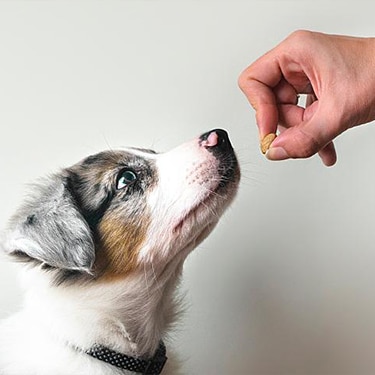
-
Find the right food for your petTake this quiz to see which food may be the best for your furry friend.Find the right food for your petTake this quiz to see which food may be the best for your furry friend.Featured products
 Adult Chicken & Barley Recipe Dog Food
Adult Chicken & Barley Recipe Dog FoodSupports lean muscle and beautiful coat for adult dogs
Shop Now Adult Large Breed Chicken & Barley Recipe Dog Food
Adult Large Breed Chicken & Barley Recipe Dog FoodSupports healthy joints, lean muscle, and beautiful coat for large breed dogs
Shop Now Hill's Science Diet Adult Chicken & Beef Entrée Dog Food
Hill's Science Diet Adult Chicken & Beef Entrée Dog FoodChicken & Beef Entrée in a delicious loaf with complete & balanced nutrition to help keep adult dogs active and healthy
Shop NowFeatured products Senior Vitality Adult 7+ Tuna & Vegetables Stew
Senior Vitality Adult 7+ Tuna & Vegetables StewImproves Everyday Ability to Get Up & Go
Shop Now Adult Tender No Corn, Wheat, Soy Chicken & Vegetables Stew Cat FoodShop Now
Adult Tender No Corn, Wheat, Soy Chicken & Vegetables Stew Cat FoodShop Now Adult Turkey & Liver Entrée Cat Food
Adult Turkey & Liver Entrée Cat FoodPrecisely balanced nutrition with the delicious taste of minced turkey & liver to help fuel the energy needs of cats during the prime of their life
Shop Now -
Dog
- Dog Tips & Articles
-
Health Category
- Weight
- Food & Environmental Sensitivities
- Urinary
- Digestive
- Joint
- Kidney
-
Life Stage
- Puppy Nutrition
- Adult Nutrition
- Senior Nutrition
Cat- Cat Tips & Articles
-
Health Category
- Weight
- Skin & Food Sensitivities
- Urinary
- Digestive
- Kidney
-
Life Stage
- Kitten Nutrition
- Adult Nutrition
Featured articles How to Properly Mix Wet & Dry Pet Foods
How to Properly Mix Wet & Dry Pet FoodsAn Orange cat eating from a bowl filled with mixed food
Read More The Science Behind Our Love for Pets
The Science Behind Our Love for PetsLearn the scientific reasons why we have such strong connections with our pets, and what science says about the love between humans and our furry friends.
Read More What Is Littermate Syndrome? Pet Adoption Guide
What Is Littermate Syndrome? Pet Adoption GuideLearn more about littermate syndrome in dogs and cats and how to successfully navigate adoption and early socialization processes.
Read More -


You might've heard from your veterinarian that fiber is key to your dog's nutrition. It's also vital for maintaining their health and managing some diseases. But how do you go about finding good fiber for dogs? Read on to learn what kind of fiber your dog may need as well as signs they could have a fiber imbalance.
The Purpose of Fiber for Dogs
Fiber is a type of complex carbohydrate. It's different from other starches in that it resists digestion in the small intestines. Typically, fiber is fermented in the large intestine, which means that it takes a lot longer to digest than simple carbohydrates.
Fiber functions to increase bulk and absorb excess water, which aids in bowel regularity and helps produce firm, formed stools. Fiber also helps produce a healthy intestinal pH which inhibits growth of undesirable bacteria in your dog's gut.
Finding Good Fiber for Dogs
When shopping for dog food containing fiber, the main things to look for are the solubility of the fiber and the amount of total digestible fiber (TGF). Soluble fiber readily disperses in water, whereas insoluble fiber maintains more of its structure in watery environments, like the gastrointestinal tract. Insoluble fiber supports dogs' gut health.
Unfortunately, pet food nutrition labels don't provide information about fiber solubility or TGF. Instead, you'll need to ask your veterinarian to help you figure out which dog food will provide what your dog needs. Keep in mind that dogs and their unique gut microbes respond differently to different fibers. This means that it will take trial and error to find the right type and amount of fiber for them.

Sources of Fiber for Dogs
The fiber in dog food comes from a variety of sources, including grains like corn and brown rice, as well as soy, beet pulp, peanut hulls, pectin and cellulose.
Many dog parents use canned pumpkin as a DIY fiber booster. However, since it's about 80 percent water, it usually doesn't contain enough fiber to provide a therapeutic benefit. If you feed your dog canned pumpkin, be sure not to give them canned pumpkin pie mix, which can be high in calories and sugar, and avoid canned pumpkin that has added sodium. You can also buy dried pumpkin powder, which can be dosed similarly to dried psyllium husk (often sold as the fiber source in Metamucil). Make sure to consult your veterinarian before adding anything to your dog's meals.


Tasty Tips
How Fiber Can Help Manage Disease
Fiber is very useful for managing diabetes in dogs, as it helps regulate blood glucose levels and minimizes fluctuations. Dog food that contains a slowly fermentable fiber can also be helpful in managing your dog's weight or aiding in weight loss. This is because fiber increases bulk and helps dogs feel full while consuming fewer calories.
Dietary fiber has been added to therapeutic pet foods to help reduce accumulation of dental plaque and tartar, balance blood cholesterol levels, control body weight and discourage dietary indiscretion (when dogs eat things they shouldn't, like non-foodstuffs or spoiled or rotten food), and help manage chronic large bowel diarrhea and constipation.
Signs of a Fiber Imbalance
If your dog has a fiber deficiency, they may have constipation or very watery stools. It's important to understand that excess fiber can also cause health issues. If your dog consumes too much fiber, they may have a hard time absorbing minerals. A fiber imbalance can lead to:
- Diarrhea
- Increased stool frequency, urgency to defecate and/or defecating in the house
Adding Fiber to Your Dog's Meal Plan
If your vet informs you that your dog needs more fiber, the simplest and most effective solution is to feed your dog a therapeutic food based on their recommended feeding instructions. Depending on what your vet tells you about your dog's specific needs, the meal plan should contain increased amounts of either soluble or insoluble fiber.
Remember that the bacteria in a dog's gut take time to acclimate to abrupt changes, as dogs eat far more routine meals than people do. Always transition to a new food slowly, over the course of one to two weeks, and know that any change to your dog's food may cause diarrhea.


Dr. Laci Schaible is a small animal veterinarian, veterinary journalist, and a thought leader in the industry. She received her Doctor of Veterinary Medicine from Texas A&M University and her Masters in Legal Studies from Wake Forest University.
Related products

Supports healthy joints, lean muscle, and beautiful coat for large breed dogs

Chicken & Beef Entrée in a delicious loaf with complete & balanced nutrition to help keep adult dogs active and healthy

Supports lean muscle and beautiful coat for adult dogs

Chicken & Barley Entrée in a delicious loaf with great taste and precisely balanced nutrition to support 5 essential building blocks for lifelong health
Related articles

Wondering where can I buy a dog? Consider adoption and explore the pros and cons of adopting a dog from a breeder versus an animal shelter.

Discover how the field of dog science is giving us more and more insights into the inner workings of our furry best friends.

Learn how to help keep your dog's immune system in tip-top shape, including nutritional immune system support for dogs and other strategies.

Can puppies have treats? Explore best practices for giving your puppy treats to ensure you're doing so in the healthiest way possible.

Put your dog on a diet without them knowing
Our low calorie formula helps you control your dog's weight. It's packed with high-quality protein for building lean muscles, and made with purposeful ingredients for a flavorful, nutritious meal. Clinically proven antioxidants, Vitamin C+E, help promote a healthy immune system.
Put your dog on a diet without them knowing
Our low calorie formula helps you control your dog's weight. It's packed with high-quality protein for building lean muscles, and made with purposeful ingredients for a flavorful, nutritious meal. Clinically proven antioxidants, Vitamin C+E, help promote a healthy immune system.

